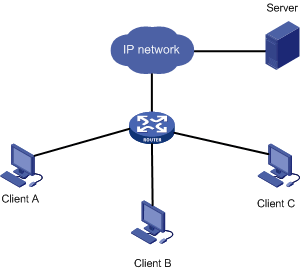Overview
Overview
INC DAM provides management and monitoring of all assets in the system. The assets refer to any terminals accessing the network, including PCs and servers.
DAM supports the following features:
-
Auto scan for asset information
The system periodically starts scanning to obtain the latest asset information, such as the asset number, owner, asset group, and asset type.
-
Monitor the usage and changes of software and hardware
The manual or auto scanning provides asset changes and this provides information for you to take measures.
-
Monitor usage of USB ports
The system allows you to monitor how the USB ports are used.
-
Deploy software to multiple assets in various ways
-
Provide different kinds of statistics reports
The reports of different kinds clearly display statistics information.
Functions
Network diagram of DAM is as below:

Network diagram of DAM
DAM provides three categories of functions: asset hardware management, asset software management, asset management policy configuration.
Provides full management of asset hardware, including information about asset group, asset management, asset hardware change, USB alarm, control scheme, peripheral management policy, illegal peripheral use report, and asset statistics.
- Asset group: Groups assets by type, location, etc for easy management. It only groups assets in the system, however, it does not manage the asset hardware.
- Asset management: Provides query for assets and hardware information. It also provides quick links for operation.
- Asset hardware change: Records hardware changes of the assets.
- USB alarm: Details the usage information about the USB ports, including when the ports are used and what kind of operation is performed.
- Control scheme: Specifies a management policy for an asset or an asset group.
- Peripheral management policy: Provides management of peripherals, such as storage devices or communication devices.
- Illegal peripheral use report: Displays details about the illegal peripherals use, including the peripheral type, device instance path, and operation time.
- Asset statistics: Provides various methods to make statistics of all assets, part assets, or the hardware.
Provides full management of software (operating system, IP address, software installation and uninstallation) of the assets, including: asset group, asset management, asset software change, software deploy task, asset statistics.
- Asset group: Groups assets by type, location, etc for easy management. It only groups assets in the system, however, it does not manage the asset hardware.
- Asset management: Provides query for assets and software information. It also provides quick links for operation.
- Asset software change: Records software changes of the assets.
- Software deploy task: Schedules to deploy and install software on to specified assets or assets in a group. This meets the unified requirements of installing and upgrading a large amount of software products in a network. Each task can be tracked and its real-time status is listed.
- Asset statistics: Provides various methods to make statistics of all assets, part assets, or the software.
Allows you to configure service parameters for management of different purposes.
User Guide
To take a quick look at the DAM management process, refer to User Guide.
FAQ
For any problems encountered in DAM management, refer to FAQ.
Typical Applications
With typical application environments and detailed operation procedures, you can quickly learn the typical applications of DAM management.

